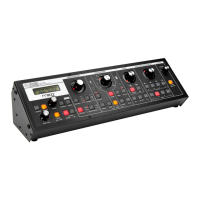Page16
SlimPhattyUser’sManualTheComponents
Page17
SlimPhattyUser’sManualTheComponents
TECHNOTES:
1.TheSP’sOverloadcircuitusesasymmetricalclipping,whichclipseachsideofthewaveform
differently.Asymmetricalclippingcircuitstendtoproducetoneswithuniquerichnessandcharacter.
2.TheOverloadcircuithasnoeffectonthesoundwhentheanalogeditcontrolissetfullycounter
clockwise.Advancingthecontrolgraduallyintroducestheeffect,startingwithagentleoverdrivelike
qualitythatbecomesincreasinglyaggressiveandedgyasthecontrolreaches100%.Becausethe
Overloadusesclipping,somesounds,suchasasquarewavewiththeltercutoffallthewayup,
aren’taffectedmuchbyincreasingtheOverloadamount.Trysoundstunedtointervalsotherthan
unison,andaslightlyresonantltersettingtoreallyheartheeffect.
3.Thename“Overload”camefromtheOverloadindicatorontheMinimoog,whereiftheoutput
waspatchedbackintotheaudioinputtheOverloadindicatorwouldgoon.MixingtheAudioin
wouldprovidea“fatter”soundbyincreasingthelevelofsignalcomingoutofthemixerandgoing
intothelter.
C. The Envelope Generators Section
Musical sounds have a start, a middle and an end. For example, a plucked
string sound starts with an initial burst of energy and then slowly fades out
until it is silent. In synthesis terms, this progression is called an envelope – a
shape that defines the changes that occur in a sound over time. An envelope
can define any aspect of change in a sound – volume, timbre, or pitch. The
circuits that create envelope control signals in synthesizers are called Enve-
lope Generators (EGs).
The Slim Phatty has two identical EG circuits. When triggered, these circuits
produce time-varying control voltages having a start, a middle and an end.
The parameters that specify this progression are the Attack, Decay, Sustain
and Release controls, abbreviated as ADSR.
Attack determines the fade-in of the envelope. The Attack control adjusts
the time it takes for the envelope to go from zero to full value (in other
words, the fade-in time) when the EG is triggered. After the Attack segment
completes, the Decay control takes over, adjusting the second stage in the
evolution. Decay is the time that it takes for the signal to drop from the full
level to the level set by the Sustain control. Once the sustain level is reached,
it will remain there as long as the trigger signal is present. When the trigger
is finally released, the Release control determines how long it takes for the
envelope to return to zero (see the ADSR Envelope Signal).
The Slim Phatty has two envelope generators; one EG is dedicated to
the amplifier (to control the volume), and one EG is dedicated to the
filter (to control the cutoff frequency). The Filter EG can also be used
as a modulation source through the Modulation Matrix.

